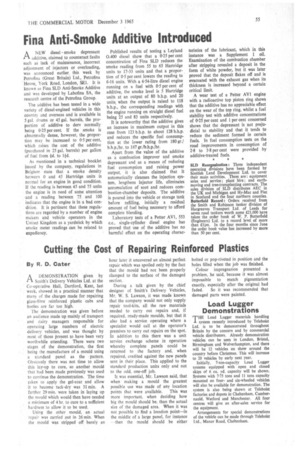Fina Anti-Smoke Additive Introduced
Page 57

If you've noticed an error in this article please click here to report it so we can fix it.
ANEW diesel smoke depressant additive, claimed to counteract faults such as lack of maintenance, incorrect adjustment of injectors or overloading, was announced earlier, this week by Petrofina (Great Britain) Ltd., Petrofina House, York Road, London, SE1. It is known as Fina SLD Anti-Smoke Additive and was developed by Labofina SA, the research centre of the Petrofina Group.
The additive has been tested in a wide variety of diesel-engined vehicles in this country and overseas and is available in 5 gal. drums or 45 gal, barrels, the proportion of additive to dery normally being 0.25 per cent. If the smoke is abnormally dense, however, the proportion may be increased to 0-5 per cent, which raises the cost of the additive (purchased in 25 gal, barrels) per gallon of fuel from id. to lid.
As mentioned in a technical booklet issued by the company, regulations in Belgium state that a smoke density between 0 and 45 Hartridge units is normal for an engine in good condition. If the reading is between 45 and 75 units the engine is in need of sortie attention and a reading between 75 and 100 indicates that the engine is in a bad condition. It is pertinent that these regulations are regarded by a number of engine makers and vehicle operators in the United Kingdom as a yardstick by which smoke meter readings can be related to expediency.
Published results of testing a Leyland 0.400 diesel show that a 0.25 per cent concentration of Fina SLD reduces the smoke reading from 55 to 65 Hartridge units to 17-33 units and that a proportion of 0-5 per cent lowers the reading to 6-16 units. With a 6.54-litre diesel engine running on a fuel with 0.5 per cent of additive, the smoke level is 5 Hartridge units at an output of 80 b.h.p. and 20 units, when the output is raised to 118 b.h.p., the corresponding readings with the engine running on straight diesel fuel being 25 and 83 units respectively.
It is noteworthy that the additive gives an increase in maximum output in this case from 123 b.h.p. to about 128 b.h.p. and reduces the specific fuel consumption at the lower rating from 180 gr.] b.h.p./hr. to 167 gr./b.h.p./hr.
Apart from the value of the additive as a combustion improver and smoke depressant and as a means of reducing fuel consumption and raising power output, it is also claimed that it automatically cleanses the injection system, lengthens injector life, eliminatesaccumulation of soot and reduces combustion-chamber deposits. The additive is poured into the vehicle or storage tank before refilling, initially a residual amount of fuel being necessary to afford complete blending.
Laboratory tests of a Petter AV1, 553 c.c., single-cylinder diesel engine has proved that use of the additive has no harmful effect on the operating charac teristics of the lubricant, which in this instance was a Supplement I oil. Examination of the combustion chamber after stripping revealed a deposit in the form of white powder, but it was later proved that the deposit flakes off and is evacuated with the exhaust gas when its thickness is increased beyond a certain critical limit.
A wear •test of a Petter AV1 engine with a radioactive top piston ring shows that the additive has no appreciable effect on the wear of the top ring, whilst a fuel stability test with additive concentrations of 0.25 per cent and 1 per cent concerned shows that the depressant is not prejudicial to stability and that it tends to reduce the sediment formed in certain fuels. In fuel consumption tests on the road improvements in consumption of 2.8 to 3-8 per cent were provided by additive-treated fuels.
SLD Reorganization : Three independent operating divisions have been formed by Scottish Land Development Ltd. to cover their main activities. These are: equipment sales and service; plant hire; and earthmoving and tree-transplanting contracts. The sales division of SLD distributes AEC in the UK and Michigan and Hy-Mac and Fiat in Scotland and the four northern counties. Butterfield Record: Orders received from the Smith and Robinson tanker division of Hargreaves Transport Ltd. of Leeds for seven road tankers worth some £21,000 have taken the order book of W. P. Butterfield (Engineers) Ltd. to a record level of more than aim. In the four months since June the order book value has increased by more than 50 per cent.
















































































































































































